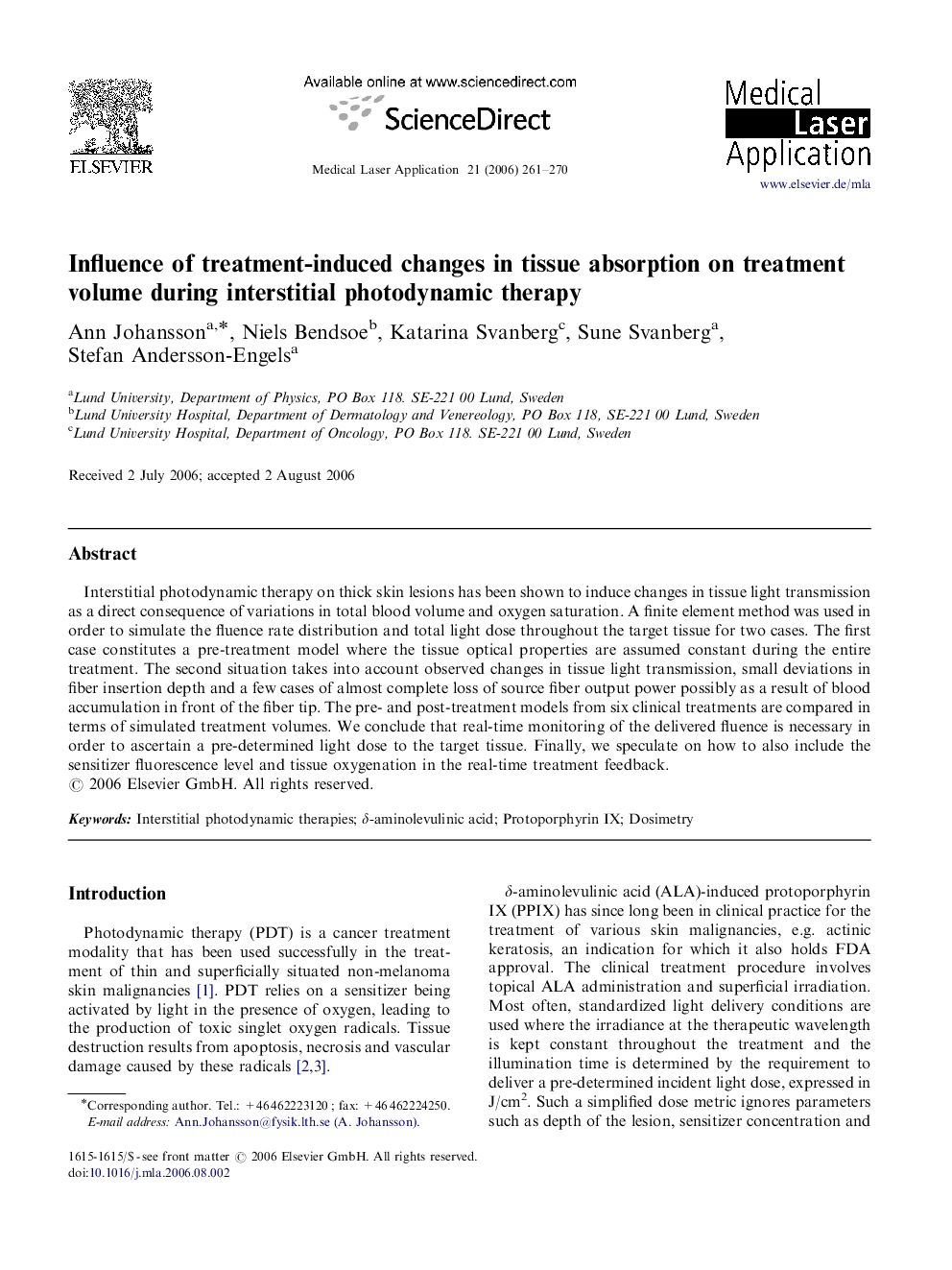| کد مقاله | کد نشریه | سال انتشار | مقاله انگلیسی | نسخه تمام متن |
|---|---|---|---|---|
| 2068472 | 1544395 | 2006 | 10 صفحه PDF | دانلود رایگان |

Interstitial photodynamic therapy on thick skin lesions has been shown to induce changes in tissue light transmission as a direct consequence of variations in total blood volume and oxygen saturation. A finite element method was used in order to simulate the fluence rate distribution and total light dose throughout the target tissue for two cases. The first case constitutes a pre-treatment model where the tissue optical properties are assumed constant during the entire treatment. The second situation takes into account observed changes in tissue light transmission, small deviations in fiber insertion depth and a few cases of almost complete loss of source fiber output power possibly as a result of blood accumulation in front of the fiber tip. The pre- and post-treatment models from six clinical treatments are compared in terms of simulated treatment volumes. We conclude that real-time monitoring of the delivered fluence is necessary in order to ascertain a pre-determined light dose to the target tissue. Finally, we speculate on how to also include the sensitizer fluorescence level and tissue oxygenation in the real-time treatment feedback.
ZusammenfassungBei der interstitiellen photodynamischen Therapie dicker Hautläsionen hat sich herausgestellt, dass Veränderungen in der Gewebelichttransmission erzeugt werden, was eine unmittelbare Folge der Schwankungen des Gesamtblutvolumens und der Sauerstoffsättigung ist. Zur Simulation der Energiedichte- und der Gesamtlichtdosisverteilung im Zielgewebe wurde in zwei Fällen eine Finite-Elemente-Methode angewandt. Im ersten Fall wird ein Modell des Zustandes vor der Behandlung festgelegt, bei dem die gewebeoptischen Eigenschaften während der gesamten Therapie als konstant angenommen werden. Bei der zweiten Simulation werden beobachtete Veränderungen der Gewebelichttransmission, geringe Abweichungen der Fasereinführungstiefe und vereinzelte Fälle von nahezu vollständigem Ausgangsleistungsverlust der Faser, möglicherweise verursacht durch vor der Faserspitze angesammeltes Blut, berücksichtigt. Die Modelle mit dem Gewebezustand vor und nach der Behandlung aus sechs klinischen Therapien werden in Bezug auf die simulierten Behandlungsvolumen verglichen. Wir kommen zu dem Schluss, dass zur Sicherstellung einer im Voraus festgelegten Lichtdosis im Zielgewebe ein Echtzeitmonitoring der abgegebenen Energiedichte erforderlich ist. Schließlich überlegen wir, wie auch das Fluoreszenzniveau des Photosensibilisators und der Sauerstoffgehalt des Gewebes in das Echtzeitbehandlungsfeedback einbezogen werden könnten.
ResúmenSe ha demostrado que la terapia fotodinámica intersticial de lesiones cutáneas gruesas provoca cambios en la transmisión de la luz del tejido como consecuencia directa de variaciones en el volumen total de sangre y la saturación de oxígeno. Para simular la distribución de la velocidad de fluencia y la dosis total de luz a través del tejido blanco, se utilizó el Método de Elementos Finitos en dos casos. El primero, constituye un modelo de pre-tratamiento en el que se asume que las propiedades ópticas del tejido son constantes durante todo el tratamiento. En el segundo, se tienen en cuenta los cambios observados en la transmisión de luz del tejido, pequeñas desviaciones en la profundidad de inserción de la fibra y algunos casos en los que se produjo una pérdida completa de salida de potencia de la fibra, probablemente como resultado de la acumulación de sangre en la punta de la misma. Los modelos de pre- y pos- tratamiento de 6 casos clínicos fueron comparados en términos de volúmenes de tratamiento. Hemos concluìdo que el monitoreo en tiempo real de la fluencia aplicada es necesario a fin de establecer una dosis predeterminada sobre el tejido blanco. Y finalmente hemos considerado cómo podría integrarse la determinación del nivel de fluorescencia del sensibilizador y de la oxigenación del tejido durante el seguimiento en tiempo real del tratamiento.
Journal: Medical Laser Application - Volume 21, Issue 4, 15 November 2006, Pages 261–270